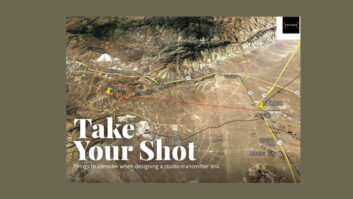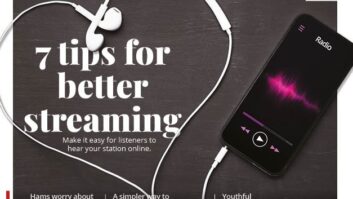The following is an abridged version of a lecture given by Bernard entitled, “Motivated to Broadcast: The Third Golden Age of Radio,” in London at the Royal Geographic Society, Oct. 5, 2005.
Radio is the simplest, purest and, I think, noblest form of electronic entertainment and, a hundred years after its invention it is still our widest-consumed and best-loved form of communication.
We are in the midst of a media revolution in which some have predicted the demise of that most elegant of all media, the wireless. I would argue the opposite is true. Multi-channel TV, the Internet, the iPod and the mobile phone are additional ways of consumers being entertained and informed and not simply alternatives to radio.
The revolution is creatively led and is a competition-driven revolution, powered by changes and developments which could not have been dreamt of even just 10 years ago but which, unmistakably are leading radio to a third golden age.
The ‘personal touch’
Throughout radio’s three golden ages, the new ideas, the concepts that really rocked the boat, have come from the edge, from left field. For a mainstream player there is no incentive to come up with disruptive ideas. Doing something different, something risky, is not something that big players welcome, indeed they often accidentally crush such ideas at the outset.
In the first golden age of radio, in the 1920s, broadcasts from overseas – from Luxembourg, Hilversum and Normandy – added something extra alongside the familiar programs of the BBC. Those overseas imports were the first example of creativity coming from the edge of the mainstream.
With the arrival of television in the 1950s, radio’s first golden age started to fade, but in the 1960s the second golden age arrived with creativity that came not from overseas but from the sea itself, from pirate broadcasters moored just outside territorial waters. That piece of creativity coincided with the invention of the transistor and its inclusion in the transistor radio.
It was 1964 and the second golden age of radio was in full swing, with pirates playing pop music, pioneering new and unstuffy ways of communicating with the public.
The third golden age of radio is driven by the arrival of digital and, as radio has always exploited the personal experience of listening, that one-to-one experience will be at the heart of radio’s success in the digital future.
The human contact, the touching of one mind by another, leads to a level of satisfaction that’s far in excess of the pleasure you get from listening to a pre-selected, no-surprises procession of tunes on an iPod. The personal touch is increased by the fact that the greater choice offered by digital radio means the station you listen to will fit your tastes more exactly.
The radio of the digital future will be your kind of music, presented by your kind of people.
DAB digital radio now gives listeners everything they ever loved about radio, but adds so much more. With digital radio, it’s the range of programs from both the BBC and the commercial broadcasters that are attracting new audiences.
And, something listeners find even more remarkable, once you’ve acquired a digital radio this extraordinary range of programs is absolutely free. No subscription or dial-up charges. In fact it’s just like the radio used to be, but much better sound and with more choice.
Research shows that digital radio is already the number one way to listen to the radio in digital homes. Despite all the fuss about listening through the TV or listening on the Internet, digital radio listening already exceeds both of these.
Fresh batch
What we learned from the first two golden ages was that listeners want something fresh and different, but they also want things that are familiar around them. It is equally important to consumers that existing local stations go digital, so while there is spectrum space being made available for new stations, we must be careful that we do the right thing with it.
Just as the overseas stations injected creativity from the edge of the mainstream in the 1920s and 1930s, and the pirates and commercial radio brought innovation in the ’60s and ’70s, new digital stations are bringing forward radio like we’ve never heard before.
There are the traditional stations of course, but there are also programs for the older market; there’s a classic rock channel, there are black music and black interest channels, Asian channels, stations for gay people and stations for children like Capital Disney and Fun Radio.
The creativity involved in the programming for these new stations is exciting producers everywhere. For the first time there is spectrum space, allowing digital programming to offer many more channels than analog spectrum. This means that channels that used to have be all things to all people need not worry about catering for everyone on one station; they can really target specific new audiences that haven’t had a place on the radio before.
An example from the GCap stable is Chill, a station that takes a sequence of cool and chilled tracks to create a very specific mood that’s proving a hit with listeners. Another example is Our Kind Of Music, a jazz, American musicals and “songbook” station we’re trying out.
These two stations are the result of individual passion and creativity which we took and nurtured within GCap. Radio needs to celebrate people of new ideas and to encourage more creativity.
By the end of 2009, industry forecasts predict more than 20 million digital radios will have been sold – equivalent to a household penetration of more than 40 percent of the U.K. That’s a more than 15-fold increase in the number of radios – a true golden age is on its way.
Making the switch
So how long before we have total U.K. conversion from analog to digital? Analog switchoff for radio is a real challenge. Commercial radio may need government help to transfer all broadcasters from analog to digital. So far income streams from analog radio have funded digital development, so effectively commercial radio’s shareholders are paying for it all at present.
A recent independent report into digital radio switchover prepared by former Culture Secretary Lord Smith explored the possibility of using the licence fees from the national commercial stations to provide grants to assist with switchover. This simply reuses money produced by commercial radio to help with the transition to digital.
There is an indication that the government could consider using part of the BBC licence fee to help commercial television with the cost of converting viewers to digital. If assistance is going to be given in television, I think that greatly strengthens the case for assistance to be given in radio.
New stations and new ideas for satisfying listeners are emerging all the time, engaging new listener populations that haven’t had a reason to listen to the radio before. Thanks to podcasting, the doors to broadcasting are now open to all with a computer, a microphone and a pair of headphones.
In analog there was little opportunity to experiment, but in digital, the seeds of creativity can be nurtured from idea to full-blown radio service. It’s a creative path that’s not been open to us before. The responsibility – for the BBC and for big companies like GCap – is to make sure we pick up those ideas and provide the finance and technical backup to make them a reality.
In the next few years, the BBC and commercial radio will be launching new digital radio stations and consumers will be able to listen on a wide range of devices. But with ubiquity and choice comes responsibility.
It is up to us broadcasters to make the programs we produce interesting, relevant, different and compelling in the way we’ve enjoyed for many years in analog radio. The comfortable pair of slippers that is analog radio will still be comfortable and will still be slippers in radio’s digital third golden age, but they’ll be treading somewhat new territory.












